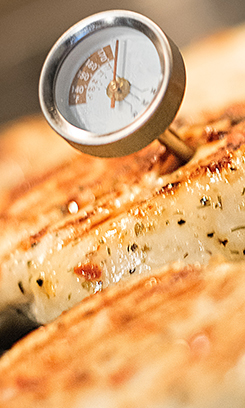Food Thermometers
It is essential to use a food thermometer when cooking meat, poultry, and egg products to prevent undercooking, verify that food has reached a safe minimum internal temperature, and consequently, prevent foodborne illness.

Why Use a Food Thermometer?
Using a food thermometer is the only reliable way to ensure safety and to determine desired “doneness” of meat, poultry, and egg products. To be safe, these foods must be cooked to a safe minimum internal temperature to destroy any harmful microorganisms that may be in the food.
“Doneness” refers to when a food is cooked to a desired state and indicates the sensory aspects of foods such as texture, appearance, and juiciness. Unlike the temperatures required for safety, these sensory aspects are subjective.
Color is Not a Reliable Indicator
Many food handlers believe that visible indicators, such as color changes, can be used to determine if foods are cooked to a point where pathogens are killed. However, recent research has shown that color and texture indicators are unreliable. For example, ground beef may turn brown before it reaches a temperature where pathogens are destroyed. A consumer preparing hamburger patties and using the brown color as an indicator of “doneness” is taking a chance that pathogenic microorganisms may survive. A hamburger cooked to 160 °F, regardless of color, is safe.
Safety Versus Doneness
The temperature at which different pathogenic microorganisms are destroyed varies, as does the “doneness” temperature for different meat and poultry. A beef, lamb, or veal roast, steak, or chop that is not pierced in any way during processing or preparation and reaches an internal temperature of 145 °F is safe to eat. Cook steaks, roasts, or chops that have been tenderized, boned, rolled, etc., to a safe minimum internal temperature of 160 °F. A pork chop or roast cooked to 160 °F is safe to eat. A consumer looking for a visual sign of “doneness” might continue cooking it until it is overcooked and dry. However, a consumer using a food thermometer to check for “doneness” can feel assured the food has reached a safe temperature and is not overcooked.
Likewise, all poultry should reach a safe minimum internal temperature of 165 °F. For reasons of personal preference, consumers may choose to cook poultry to higher temperatures for acceptability and palatability.
A food thermometer should also be used to ensure that cooked food is held at safe temperatures until served. Cold foods should be held at 40 °F or below. Hot food should be kept hot at 140 °F or above.

